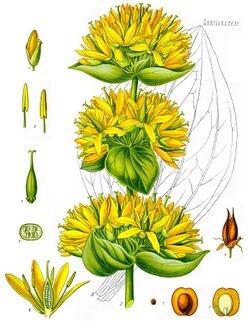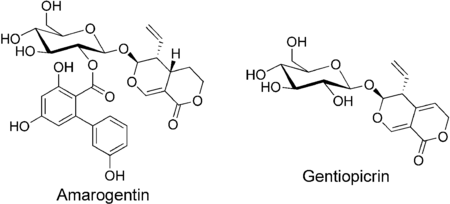Biology:Gentiana lutea
| Gentiana lutea | |
|---|---|

| |
| Scientific classification | |
| Kingdom: | Plantae |
| Clade: | Tracheophytes |
| Clade: | Angiosperms |
| Clade: | Eudicots |
| Clade: | Asterids |
| Order: | Gentianales |
| Family: | Gentianaceae |
| Genus: | Gentiana |
| Species: | G. lutea
|
| Binomial name | |
| Gentiana lutea | |
Gentiana lutea, the great yellow gentian, is a species of gentian native to the mountains of central and southern Europe.
Growth
Gentiana lutea is an herbaceous perennial plant, growing to 1–2 m (3.3–6.6 ft) tall, with broad lanceolate to elliptic leaves 10–30 cm (3.9–11.8 in) long and 4–12 cm (1.6–4.7 in) broad. The flowers are yellow, with the corolla separated nearly to the base into 5–7 narrow petals. It grows in grassy alpine and sub-alpine pastures, usually on calcareous soils.
Uses
Gentiana lutea is remarkable for the intense bitterness of the root and every part of the herbage. Before the introduction of hops, gentian was used occasionally in brewing.
Gentian root has a long history of use as an herbal bitter and is an ingredient of many proprietary medicines. The parts used include the dried, underground parts of the plant and the fresh, above-ground parts. The root, which can be over 5 cm (2.0 in) thick and has few branches, is harvested in the autumn and dried for later use. Caution should be exercised as to its use because it is endangered,[citation needed] and the closely related Centaurium erythraea shares many of its constituents and actions.[citation needed]
The name is a tribute to Gentius, an Illyrian king who was thought[1] to have found out that the herb had tonic properties.
In veterinary pharmacopeia in the 1860s, gentian root or gentian radix was considered useful as a tonic and stomachic.[2][3]
Extracts of gentian root can be found in the United States soft drink Moxie, and its unique flavor is attributed to that fact. It is used in France to produce a number of bitter liqueurs, including Salers (Liqueur de gentiane) in the Cantal, and a Limousin specialty liqueur and aperitif called Avèze (liqueur) (fr). The plants are now cultivated in the Auvergne area in view of their protected status, and they are no longer harvested from the wild in the Auvergne mountains.
The European Gentian Association in Lausanne has the objective to develop the knowledge and uses of yellow gentian and other species of Gentianaceae.
Gentiana lutea is depicted on the reverse of the Albanian 2000 lek banknote, issued in 2008. The note depicts King Gentius on its obverse.[4]
Chemical constituents
The bitter principles of gentian root are secoiridoid glycosides amarogentin and gentiopicrin. The former is one of the most bitter natural compounds known[5] and is used as a scientific basis for measuring bitterness.
References
- ↑ Jepson, Willis Linn (January 1, 1975). A Manual of the Flowering Plants of California. University of California Press. ISBN 9780520006065. https://books.google.com/books?id=bffkmpjLa8EC&dq=Gentiana+gentius&pg=PA763.
- ↑ page 126 of Tuson, Richard V.; Bayne, James (1895), A pharmacopoeia including the outlines of materia medica and therapeutics for the use of practitioners and students of veterinary medicine (5th ed.), Philadelphia P. Blakiston, Son & Co, http://trove.nla.gov.au/work/15256665, retrieved 28 October 2011
- ↑ Tuson, Richard V. (February 12, 1895). A pharmacopoeia including the outlines of materia medica and therapeutics for the use of practitioners and students of veterinary medicine. P. Blakiston, Son & Co.. https://openlibrary.org/books/OL24167194M/A_pharmacopoeia_including_the_outlines_of_materia_medica_and_therapeutics_for_the_use_of_practitione.
- ↑ Bank of Albania. Currency: "Banknotes in circulation". . Bank of Albania. Retrieved on 23 March 2009.
- ↑ "Heilpflanzen: Gentiana lutea" (in German)
External links
Wikidata ☰ Q158572 entry
 |



